It can be a struggle to find appropriate homeschool curriculum for your family. My oldest twins turned five this month. Although they missed the public school cutoff for kindergarten in our area by 15 days, they are academically and socially mature enough for kindergarten. The caveat is that I don’t think my biggest boy would do well in a public school setting.
Good think we always planned to homeschool! I’ve been researching curriculum for months and purchased a bunch of it this past spring. They aren’t ready for all of it all at the same time, so we’ve been phasing it in over the summer to get our collective homeschool legs under us.
It’s funny that people I run into seem to think I have more patience or a particular talent with young kids to have three sets of twins in about three years. Well, no, and that applies to homeschool too. I don’t automatically know what I’m doing. I’m winging it like the rest of the new homeschool parents, though perhaps less than the so-called “covid homeschoolers” who have been thrown into homeschooling with little to no warning.
This is the year of homeschooling. The COVID-19 pandemic has caused many schools to move to partly or wholly online instruction. For many students and families, it just doesn’t work. It combines the time requirement of public school with the daily responsibility of supervising your children’s education. As a result, many people who would have never considered homeschooling before find themselves perusing homeschool curriculum options.
Our complete Kindergarten and Pre-K homeschool curriculum
Whether you planned to homeschool or fine yourself pushed into it, let me show you what we’re doing. Some of these you may have seen in my prior post about our morning basket. I tried to collect a broad spectrum of subjects to introduce the bigs (and middles) to a little bit of everything. Some of these we use daily, and some are only once a week. My focus is on getting them ready to learn independently.
To that end, our main academic foci are on reading, math, and handwriting. I chose curriculum that I thought would work for advanced or struggling learners just in case my younger children don’t take to academics as readily as my oldest.
Summary of choices
Here’s your quick-start guide to our homeschool curriculum spread this year:
- Reading: All About Reading
- Math: Math Mammoth
- Handwriting: A Reason for Handwriting
- Character: Little Lads and Ladies of Virtue
- Science: mom-designed unit studies
- Geography: Evan-Moor Beginning Geography (K-2)
- Music: Music for Little Mozarts (piano instruction)
- German: cartoons and a coloring book with words and phrases
- Religion: Byzikids Magazine
If you want more in-depth flip throughs or reviews of any of these, leave a comment below.
Reading: All About Reading
For a new homeschool parent, All About Reading is great! It’s very open and go. I used to review the lesson before I taught it, but since I’m used to the format now I often skim it right before we talk about it. Parents might need to do a little preparation, like cutting out game pieces or choosing activities to make review more fun, but it gets faster with familiarity.
I would highly recommend this homeschool curriculum to a parent who is nervous about teaching their kids to read. (That was me earlier this year.) The publisher has superb customer support, too, if you have any questions or problems. Before choosing a level, have your child try their free reading placement tests.
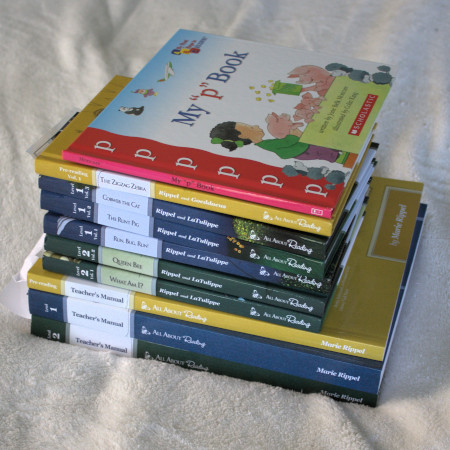
My bigs started with All About Reading level 1 earlier this year and went through it faster than I expected, so they’re about 20% of the way through level 2 already. I expect that we’ll have to purchase level 3 at some point this year.
The middles are almost done with All About Reading pre-reading. They’re chomping at the bit to read, just like their big brother and big sister! They’re finishing the last set of lessons as fast as I’ll let them–one letter per day. Lucky for me, I already have level 1 prepped and ready to go.
So far the kids have really liked the activities in All About Reading. I try to work on reading 4-5 days each week. The practice sheets are very dry if taken at face value, but the teacher manual provides a lot of ideas for how to make them more fun. Pre-reading is very quick to do even at one lesson per day. A single lesson for levels 1 and 2 might span more than a day, depending on how quickly the child picks up on reading.
Math: Math Mammoth
Math Mammoth might be one of the most affordable math homeschool curriculum options on the market. It’s straightforward and only requires one book (or PDF download). It looks like it’s very heavy on worksheets, but in the notes to the instructor it lists a bunch of websites and games to make math more fun. We’re using the light blue series, which is organized by grade level. They also have the blue series (organized by subject) and a few supplemental book series. Like All About Reading, I highly recommend using the free math placement test.
Even my bigs are not fluent with handwriting yet, so we’re talking about the pages rather than having them work independently. I’m also incorporating games as I can manage. We recently played war with standard playing cards. The bigs flipped two cards (two decks with everything above 5 pulled out), added them, and whoever had the higher sum won the round. I had the middles practice reading numbers up to 10 and comparing which is bigger. I try to incorporate some sort of math at least 2-3 days per week. One of my shorter term goals is to increase this to 4-5 days per week like reading.
Our reading program had a sticker progress chart that was such a hit with the kids that I designed sticker charts for their handwriting and math. Although they might not earn a sticker every day, it gives them a little incentive to make progress.
Handwriting: A Reason for Handwriting
For handwriting I ask them to do a little each day, not a full lesson from the curriculum. I think they’re finding A Reason for Handwriting a bit dry because it is often a struggle to get them to write more than a couple of characters. I’m not sure if that’s endemic to handwriting or specific to our curriculum. (Any tips from veteran homeschoolers?)
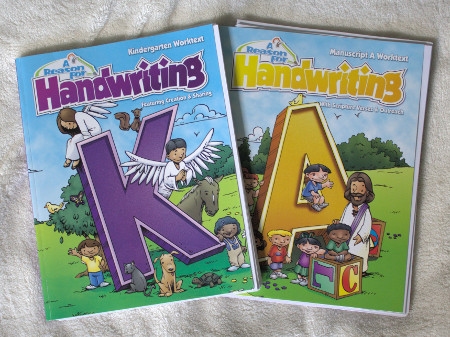
I chose A Reason for Handwriting because I like the way the curriculum forms letters, it methodically teaches all the letters, and it incorporates scripture each week starting in level A. However, if my kids don’t want to do the work, it doesn’t matter how methodical or character building it is. This is probably my least favorite choice so far this year.
I also have Draw Write Now on my shelf. We did a tiny bit of the drawing component in the past and the kids seem to really like it. I might try to use the drawing as a lure to get them to do the copy work that goes with it.
Character: Little Lads and Ladies of Virtue
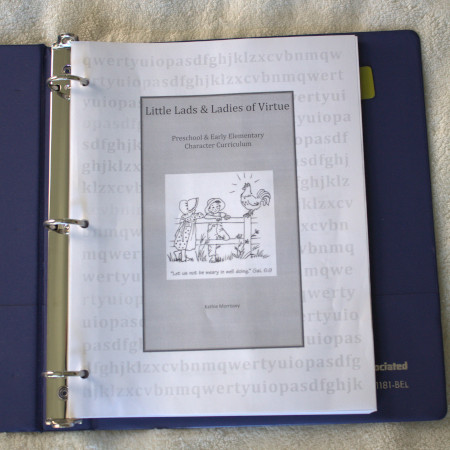
So far, I love Little Lads and Ladies of Virtue! It’s again very straightforward and requires little preparation. The curriculum consists of 24 character traits and each trait includes 5 lessons to make a one-week study. It is geared towards preschool through early elementary students. It tells me exactly what to do and most days only take 5-10 minutes over breakfast or lunch. I also love that I can use it for my bigs and middles at the same time.
Science: mom-designed unit studies
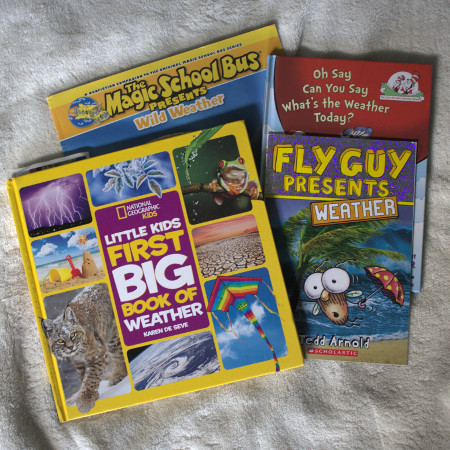
Science isn’t a huge topic of formal study in kindergarten or pre-K, so I’m kind of winging it. I bought some National Geographic Big Books, along with corresponding Magic School Bus books and videos and Cat in the Hat Learning Library books. I have not looked into Magic School Bus Rides Again. If you have tried it, please share what you think of it in the comments.
All we’re doing right now is read alouds from these books. I have a few experiments planned if I can get myself organized enough (and brave enough) to try them. So far all of the organized homeschool curriculum options for science look too involved for what I want to do with my kids at this age.
Geography: Evan-Moor Beginning Geography (K-2)
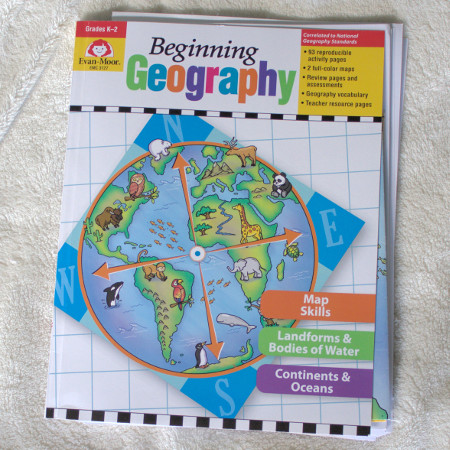
Evan-Moor Beginning Geography looks like a workbook, but the munchkins really like the worksheets so far. When we get to some of the more writing intensive ones, I might have to switch to oral instead of written answers, like with math, to avoid frustration that is unrelated to the subject at hand.
Geography might seem like a weird topic to throw at a kindergartner, but I think maps will be extremely useful for my kids to learn independently at an earlier age. (Note that when I say “learn independently” I don’t mean that I bow out as their teacher. It’s more like a kid transitioning from learning to read to reading to learn.) Not to mention, my oldest son has taken an interest in the United States map on our wall. May as well harness his interest and see if I can rope in some other kids! I aim to incorporate this once or twice a week.
Music: Music for Little Mozarts
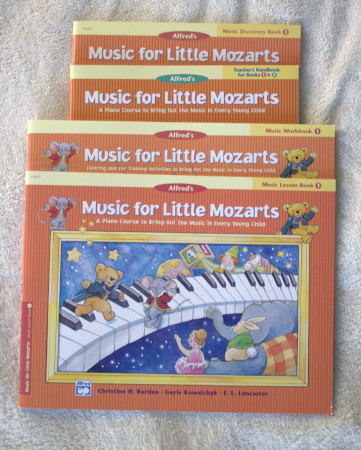
We haven’t actually started using Music for Little Mozarts yet. It is designed for late preschool to early elementary school kids, so it’s exactly the right level for my kids.
However, I’m intimidated by the prospect of trying to teach piano, which I don’t know how to play, to 2-4 kids five and under while two toddlers try to stick themselves in the middle of it or destroy the rest of the house around us. I have some background in music and the curriculum looks easy to follow. One of these days I might have to muster up some courage to court disaster.
German: cartoons and a coloring book with words and phrases

I know some German, so I can at least sort of help with pronunciation. Jeff speaks German very fluently. I want to introduce the sound of a foreign language to the munchkins early even if they don’t remember more than a few words. I think a little groundwork may pay off in a few years when they are ready for more organized study. To that end, cartoons like Die Biene Maja (Maya the Bee) and coloring books are as far as we’re going for now. I am not opposed to something more organized. I just haven’t found any homeschool curriculum appropriate for five and under.
Religion: Byzikids Magazine
I really struggled to find a religion curriculum. We’re part of the Melkite church, one of the branches of Byzantine Catholicism. There’s a whole lot out there for Latin Catholics, but not much for us Byzantines.
The only two viable year-long curriculum options I found seemed beyond my ability to convey. I grew up with little to no knowledge of religion or the bible, so I’m learning as much as the munchkins. Since we started attending church a couple of years ago, I’ve had very little time to devote to studying the bible or liturgy. I don’t even know when I’m supposed to bow or cross myself or any of the other basic habits. Any curriculum that says “don’t read this verbatim” is not for me.
Enter Byzikids Magazine. I might be as excited about this as I am about the Little Lads and Ladies of Virtue. Each monthly issue comes with weekly lesson plans, a list of daily habits, and a monthly calendar with special days and feast or fast days noted. It even lists the page numbers of things that I can read word for word! That is exactly what this lost mama needs. Some of the material is a bit too advanced for my kids, but I can see how they will grow into this magazine over the next several years.
Curriculum Wrap up
I hope you found this helpful. You can find much more information about homeschool curriculum options of Cathy Duffy Reviews. She posts great reviews of a multitude of curriculum options. I highly recommend reading reviews there before choosing anything.
Rainbow Resource Center, ChristianBook, Homeschool Buyers Co-op, and Amazon have been my best sources for paid materials besides those I purchased directly from the publisher.
Remember that curriculum is a tool, not a prison. Use it and modify it to fit your needs. You do not need to ask anyone’s permission to skip something or go off on a tangent and leave behind formal study for a few days.
Whether you jumped or were pushed into homeschooling, I wish you well in your journey.



Thanks so much for the kind words about our publication!!
We’re so glad to know it’s useful and appreciated.
God bless your homeschool!